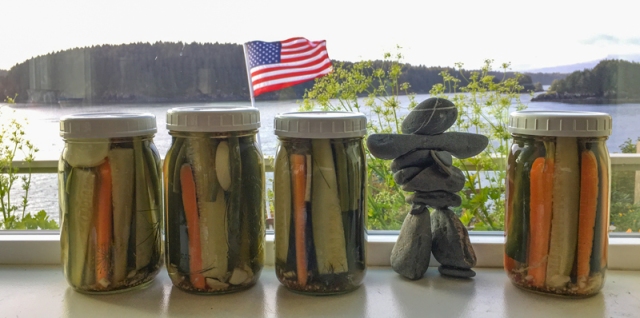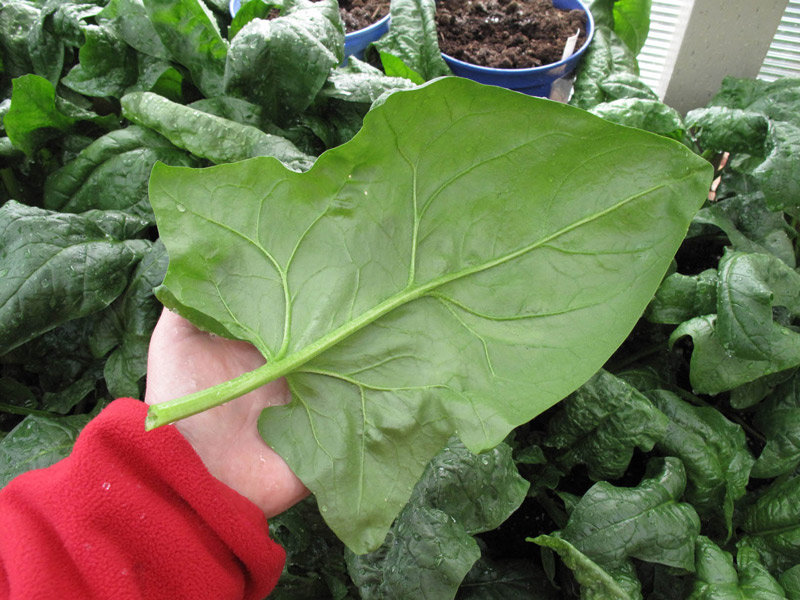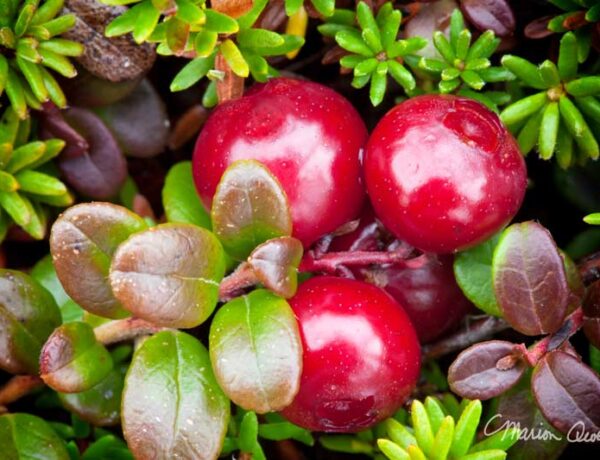This article was originally published as one of my weekly garden columns…
Let me begin with a gentle apology: Professional columnists say you should never devote your columns to more than one topic. Fat chance. Here in Kodiak, Alaska, there’s so much going on that it’s impossible for me to follow their advice. So this week you get a bonus: Three topics for the price of one. (Of course I’m kidding about the price). I think you’ll enjoy the variety:
- How to overwinter spinach (harvest fresh greens in February)
- My favorite refrigerator pickle (mix ‘n match veggies)
- What’s an aronia berry? (hint: It has more nutritional punch than blueberries)
The fall season means prepping the garden for next spring. But it’s also planting time. Yes, while you’re yanking out faded pansies and tired lettuce, spinach seeds need to be planted. Now you might be thinking, “But it’s September, in Alaska. Why are you telling us about sowing seeds?” This is a heads-up for anyone living north of the Mason-Dixon line: The first two weeks of September is the best time to sow spinach for harvesting next spring.
Kale and cress might be the Rock ‘n Roll stars of veggies, but spinach is the best winter green for northern climates. It loves cool temperatures and tolerates winter weather if, and only if, the seeds are sown early enough for the plants to establish roots.
1) How to overwinter spinach: Our favorite winter green
I learned about overwintering spinach through Eliot Coleman, while reading his landmark book, The Winter Harvest Handbook. “In cold houses,” he says, “Spinach continues producing new leaves all winter unlike, say kale, another cold-hardy crop, which stops new growth during the cold months.”
In Kodiak, we sow spinach seeds in outside beds, greenhouses or hoophouses. Favorite varieties include Olympia, Space and Tyee. For outdoor raised beds, you’ll want to provide a protective cover such as a cold frame, fiberglass or perforated plastic. The plants will grow to 2 to 4 inches in height, and then when the day length drops below 10 hours (around October 20 for our latitude), growth slows to a crawl.
To access the Duration of Daylight table for your latitude, click here.
During the winter months, keep the soil barely moist (not soggy). Too dry and the seedlings won’t have enough root structure to produce a crop in March.
Around February 20, the day length (for our latitude), crests over the 10-hour mark. Like magic, the spinach resumes growing, and you’re on your way to fresh salads.
While you’re waiting for your spinach seeds to germinate why not make a batch of pickles? Below is my all-time favorite refrigerator pickle recipe. They are easy to make and require no processing in a boiling water bath. And you can mix and match veggies: cucumbers, carrots, green onions, onions, green beans, bits of cauliflower, zucchini, you name it.

What can I say? My favorite refrigerator pickle recipe gives me an excuse to be creative in a quart jar.
2) My favorite refrigerator pickle recipe
This recipe is excellent for anyone who is new to pickling and since many vegetables are pickle-friendly, you’re not limited to cucumbers. (If love pickles, be sure to try rhubarb pickles). Yields 2 quarts.
Brine ingredients :
4 cups water
2 cups white vinegar (For a sweet ‘n sour pickle use cider vinegar and add 1 cup sugar to each 2 cups vinegar)
8-10 cloves garlic, peeled
6 tsp non-iodized (kosher or canning) salt
Several sprigs of fresh dill
1 tsp each celery seed, coriander seed, and mustard seed
1/2 tsp black peppercorns (optional)
Crushed red peppers
Vegetables (6-7 cups):
Cucumbers, sliced into 1/8-inch slices or into cut lengthwise into sticks
Carrots, small whole, or cut in half lengthwise
Green onion pieces
Green beans
Chinese snow peas
Edamame (soy beans)
Cauliflower pieces
Sliced white turnip
Fennel slices
In a stainless or other non-reactive pan, bring water to a boil, reduce the heat, add the garlic and let it simmer for about for 5 minutes. Add the vinegar and salt (add sugar now if you’re going to use it), raise the heat and bring to a boil, stirring until everything is dissolved. Remove from heat. Into each 1-quart jar, pack a few sprigs of dill and a pinch of crushed red peppers. Divide the seeds and garlic between the jars. Then pack the jars snug (but not too tight) with vegetables. Bring the brine back to a boil, pour it over the vegetables to cover completely. Let it cool, then cover and refrigerate. The pickles will taste good in a few hours, though better after a couple of days. They’ll keep for 3 to 6 months.
3) What are aronia berries?
With all the emphasis on eating local foods (that includes foraging), it’s nice to find trees and shrubs that work double-duty in your garden, that is, as an ornamental plant and as a food source. Meet aronia, an overlooked member of the Rosacea (rose) family, that’s native to the Eastern U.S. and is often found in wet woods and marshy areas.

Picking berries from our aronia bush requires wearing a life jacket (just kidding) because the plant hangs over the cliff at our oceanside home/B&B in Kodiak, Alaska. The effort is well worth the stretching exercises, though. (Marion Owen photo)
Aronia, also called chokeberries, produce red or black berries, depending on the variety. fresh, but because of their tartness, most people process them into jams, jellies, juices, teas (Poland) and wine (Lithuania). The midnight blue berries mix well with black currants, blackberries, and blueberries. Another tidbit about aronia berries is that they are also used as a flavoring or colorant for beverages and yogurts. By the way, blogger Donna Stewart has an excellent recipe for GLAM Jam, that’s Ginger, Lime, Aronia and Maple.
Aronia berries’ deep color should give you a clue that they contain a healthy amount of polyphenols, especially anthocyanins (antioxidants). In fact, chokeberries contain some of the highest anthocyanins measured in plants, said to contain three times the antioxidants than blueberries.
But that’s not the end of aronia’s beauty. After a summer of dainty white blossoms which give way to purple-blue berries, this shrub really comes into its own in the fall when its leaves turn a pleasing yellow, orange and red. It’s these leaves that I see from my kitchen window as I sip coffee, watch eagles fly by, make pickles…
Thanks for visiting…







No Comments
Melissa
September 22, 2016 at 3:06 PMHi, I often make refrigerator pickles one jar at a time. My mother always made pickled beets in the fall to eat at Thanksgiving. She just used canned sliced beets, red onion, white vinegar and very little sugar. Later the onions were the best on a sandwich! Last year someone suggested a few cloves in the recipe and we really enjoyed the flavor. I was wondering does anyone else use cloves. I like my pickles very sour but my grandmother liked the “bread and butter” pickles.
Thanks for promoting refrigerator pickles! M.
Sharon
September 13, 2016 at 9:15 AMI’m here on the other side of your world in Southern California but enjoyed your post so much. It’s obvious you have such a busy schedule but I look forward to seeing more of your posts when you have time. Love your refrigerator pickle recipe!
marionowen
September 13, 2016 at 5:33 PMHi Sharon… yes, you really are in the Lower 48 as we call it. We venture down there once or twice a year; I like to attend a silent retreat in Encinitas, CA and we have our RV in Phoenix. Hoping your fall season is a lovely one. Cheers and thanks for saying hi. — Marion
Helen Raschick
September 13, 2016 at 9:09 AMGreat article, thank you! My favorite thing to pickle is beets!
marionowen
September 13, 2016 at 9:13 AMMe, too Helen. I love, love, love pickled beets. I have a recipe for a beet salad called Kremlin Salad from a Russian friend. Called that because all the old men in Russia need extra “help” says my friend.
June
September 13, 2016 at 6:08 AMThank you Marion for the lagniappe. I have not heard of aronia berries before. Is this a shrub that the Garden Center sells?
marionowen
September 13, 2016 at 8:41 AMA few garden centers carry them, but most people don’t know about them — quite undiscovered.
Helen M Williams
September 13, 2016 at 5:41 AMMarion, So glad you’re back- have missed your posts. I marvel at how you can make spinach look awesome. Thanks for the recipes. Helen
marionowen
September 13, 2016 at 8:38 AMHi Helen, oh thank you! Our summers are quite busy, what with running a B&B here in Kodiak and operating wildlife viewing trips and gourmet dinner cruises from our boat–this year we did 130 trips! Still, life is good and I look forward to sharing more posts. Cheers and blessings to you! — Marion
Linda
September 12, 2016 at 6:01 PMO Wow- I love this informative post. Thank you so very much.
marionowen
September 13, 2016 at 8:39 AMYou are most welcome, Linda. Look forward to more… blessings to you, Marion